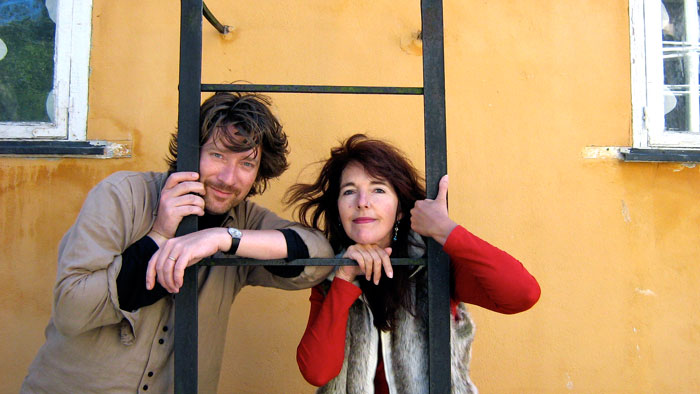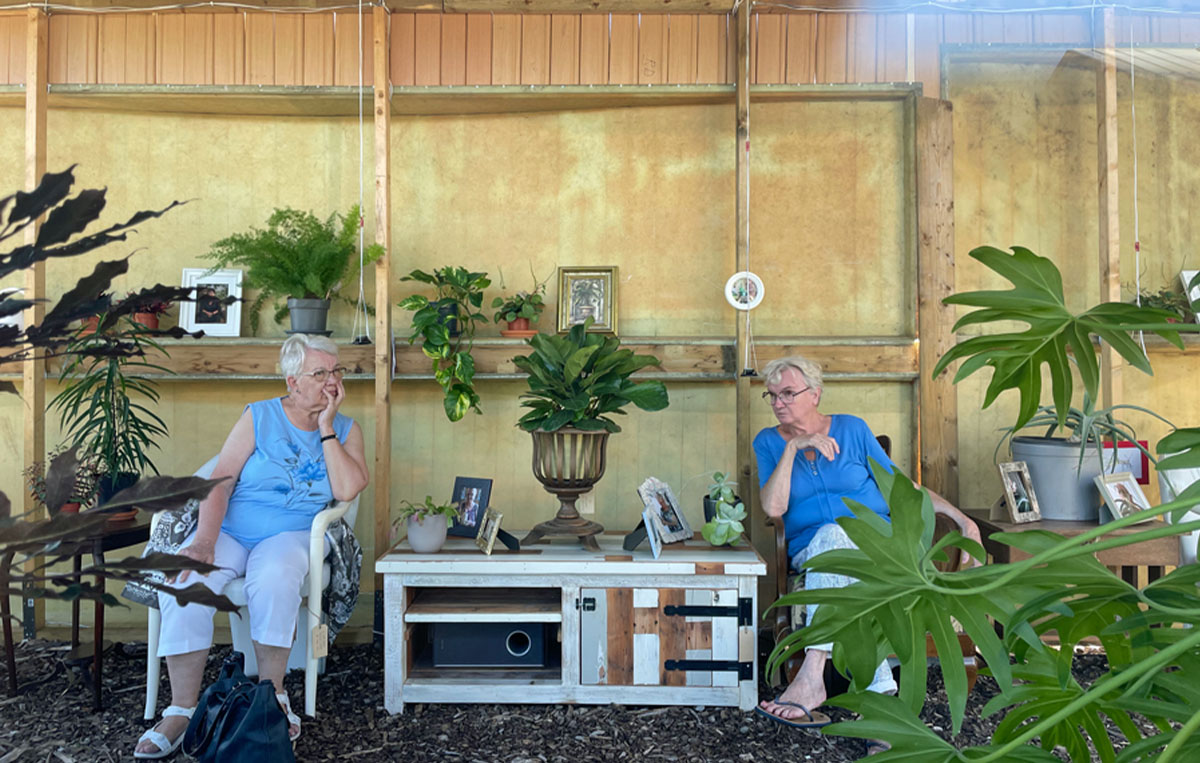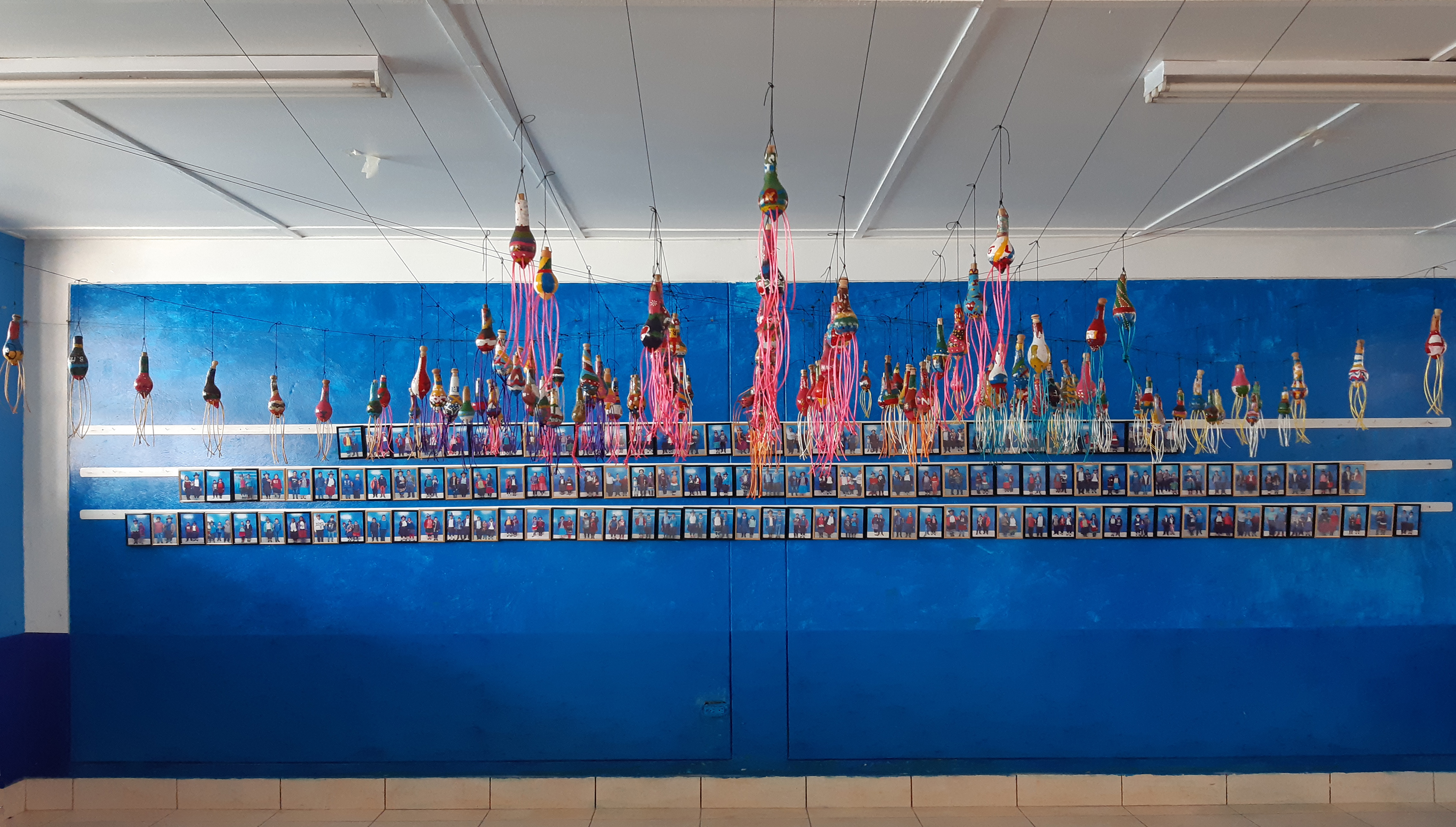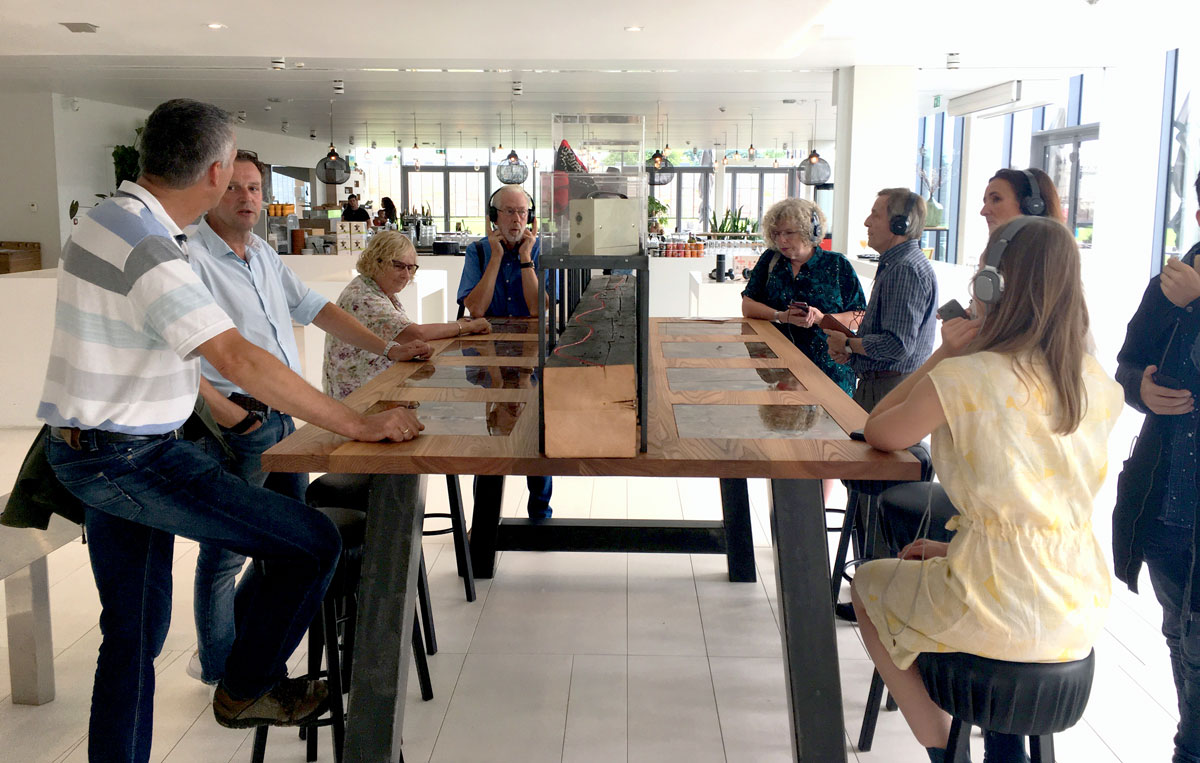Art Projects
Art on Location
Arno Peeters and Iris Honderdos
Introduction
Iris Honderdos (film, photography, installations) and Arno Peeters (multimedia and sound) are ‘community based’ artists and they have a worldwide experience in this field.
Since 2003 they live and work together and collaborated on projects in the Czech Republic with former miners and their wives, in the Ukraine during the Orange Revolution and worked extensively in North-Vietnam with HIV infected women and female ex-drug users. More recent projects took them to Bulgaria, Norway, Peru and Finland.
In their method of working they cannot know upfront what they will create, since they need to home in on the emotions of the community they want to work with. After a process of research and meditation on a subject, sketching and modeling, the actual work on the art itself can begin. It results mostly in an installation, accompanied by sound or video and is presented to the audience during a performance or concert; it is a gift to the community.
Their approach proved to be very suitable for addressing complex or sensitive issues within local communities. Therefore they have been contracted by several NGOs. They have worked for the Medical Committee Netherlands Vietnam, for Cordaid in Sierra Leone, the Royal Tropical Institute in Meghalaya and Uganda and for The Institute of Development Studies in Kenya.
More information
Some examples of their work:
- Aandacht II (Utrecht, The Netherlands, 2022)
- Elämänlanka (Mänttä-Vilppula, Finland, 2021)
- Los Purus (Canchabamba, Peru, 2019)
- Mensen op de Limes (Leidsche Rijn - The Netherlands, 2019)
- Terra (Volterra - Italy, 2018)
- Aandacht (Leidsche Rijn - The Netherlands, 2017)
- Cre Dogma (Leveld - Norway, 2016)
- Love Matters - The Show (Nairobi - Kenya, 2015)
- Faces of Rosen (Rosen - Bulgaria, 2014)
- Inside Out (Koudum - The Netherlands, 2013)
- Rooted (Mount Elgon - Uganda, 2012)
- Red, Gold and Green (Meghalaya - India, 2012)
- With Love From.... (Yerevan - Armenia, 2011)
- Turning To Raseborg (Ekenäs - Finland, 2008)
- Cao Bang Festival (Cao Bang - Vietnam, 2007)
- Cactus Blossoms in The Sand (Hanoi, Vietnam, 2006)
- Monument for a Revolution (Kiev, Ukraine 2004/2005)
- Fossile Sound, Memory Mining (Mayrau Mine, Kladno, Czechia 2004)
Aandacht II (Utrecht, The Netherlands, 2022)
During a few months leading up to the project, Iris visited the multicultural district of Overvecht. With her thorough approach, based on years of experience with in-depth interviews, she knows how to win people's trust. The very personal stories she recorded were embedded in a professional soundscape composed by Arno Peeters. Iris asked its owners about what the plant has been witnessing in their lives: the plant forms the central point, both in the stories and in the installation.
The houseplant served as a starting point. Plants that have been with a resident for a long time often have special stories attached to them. Stories that go beyond the facts about the houseplant. Sometimes the houseplants are inherited and perpetuate the link with the deceased or with the person who has lost sight of them. They may symbolize a different culture or be a true buddy in the windowsill. Plants are often gifts reminiscent of beautiful relationships. They are true entities in the home for some people, with whom they live and lovingly care for.
In a small garden greenhouse at local garden center Steck, the plants 'stayed over' during the exhibition. A soundscape played from all corners of the green house and additionally the actual stories are played from 11 small speakers close above the plants: this way, the plants will have the voice of their caretakers close and their portrait nearby as a memory of home. Visitors would have to sit down in comfy chairs and put their ears close to the plant to be able to hear its story.
This installation was part of the pop-up exhibition Utrecht Down Under - kunst op volle grond.
- Listen to an interview with Iris on Opium (Dutch National Radio 4)
- Article about the exhibition by Peke Hofman
BACK TO TOP
Elämänlanka (Mänttä-Vilppula, Finland, 2021)
Elämänlanka means ‘Thread of life’ in Finnish and is an installation made with clients from the Open Prison in Mänttä-Vilppula.
Each tree represents the life of one client. The red lines are their lifelines and the steel collars mark important moments in their lives, from which metal wires run up.
On the left side of the rope you see the moments with bad memories, on the right side of the rope the positive and pleasant ones. It starts with birth on the lowest band and ends with the moment here and now, at the top of the tree.
A sign with a QR-code gives you a podcast in which the clients tell their stories and experiences during the process.
This artwork was realised during a two-month stay at the Serlachius Residency.
A documentary is in the making and will be finished late 2022, but meanwhile you can read our Residency Report
- The clients of Vilppula Open Prison are involved in the community Lifestyle Art project Article on the site of RISE, the Criminal Sanctions Agency (in Finnish)
- The podcast with prisoners (in Finnish).
- A Way to Sound, a Day at the Museum and Seasonscapes, a collection of three short videopieces Arno made during the residency.
BACK TO TOP
Los Purus (Canchabamba, Peru, 2019)
Canchabamba, a small rural community high up in the Peruvian Andes (3200m) is home to a few dozen inhabitants and to "I.E 86453 Juan Velasco Alvarado", a large school with over 240 students ranging, from 6 to 18 years of age. It is one of the few areas accessible by car, but many of the students have to walk for hours to reach it.
We have stayed for 4 weeks in the village and created an installation with the students, consisting of 138 'purus': it's the Quechua word for a small gourd or calabash. It has been used for over ages as a container for coca juice and medicine or magic potion. The students have decorated them and they contain letters by the students to their future self, accompanied by a secret note from their parents. They can take their own puru out of the installation once they leave school and choose whether to break the seal and read the messages or wait for another moment. The idea is that the empty space can than be filled with a new puru from a student that is just starting out in school.
Iris made a personal account of Los Purus: impressions, encounters, the quest and making process. It is available in Dutch, Spanish and Spanish with English substitles.
- Travelogue Part 1 and Part 2 (PDF)
- A short video-interview on location.
- El Kamishibai y las Máscaras Teatrales, the documentary we made for the school.
BACK TO TOP
Mensen op de Limes (Leidsche Rijn - The Netherlands, 2019)
A Limes was a fortified frontier of the Roman Empire, stretching all the way from Rome as far as Britain; with over 500 kilometers, it could monitor and hinder any invaders or raiders before they reached the "civilized" interior.
As part of the theater performance 'GRENS' by Nieuw Utrechts Toneel, Iris Honderdos got inspired by the Limes, the largest archaeological monument in the Netherlands. She visited several people who literally live on the Limes nowadays, talked to them about what brought them here and collected stories about objects that play an important role in their lives. We can only guess at the personal stories behind the excavated objects from Roman times, but we can preserve and share the stories of the objects that are now - in the present - on the Limes.
As a contemporary archaeologist, Iris has 'excavated' the objects and their stories and exhibits them in a specially designed table. You can sit at the table and by scanning the QR code with your mobile phone, bring the stories of the objects to life. Arno Peeters created soundscapes to accompany these stories and it is worth listening with headphones. The installation has been on display at Castellum Hoge Woerd and at the the city Hall in Utrecht.
- Listen to the stories (Dutch, headphones recommended)
- Review by Youetta Visser (Dutch)
BACK TO TOP
Terra (Volterra - Italy, 2018)
This film was made for the 20-year anniversary of Teatro di Nascosto ("Hidden Theater"), between November 23 and 25, 2018. The actors of Teatro di Nascosto came from several Middle East and Western countries to celebrate their anniversary in Volterra, Italy. We’ve asked the actors to bring some soil or sand from the place where they live and tell us about their relationship with land.
The whole production was created during the festival and presented on the final evening.
- Video: Iris Honderdos
- Soundscape: Arno Peeters
- Oud played by Alex Etchart
BACK TO TOP
Aandacht (Leidsche Rijn - The Netherlands, 2017)
After 7 years living in Leidsche Rijn , a fast-growing neighbourhood in the west of Utrecht, Iris started wondering about all the new neighbours that had come to live there in the recent years. Especially in the spring of 2017, when the very last patches of open space close to her own house in De Kersenboomgaard, (‘The Cherry Orchard’) were being filled with new housing.
One thing she noticed was that one of the first things people do when they move into their new house is to put something on the windows to prevent passers-by from looking inside; sometimes blinds, but mostly semi-transparent plastic sheets in all kinds of patterns. Sometimes, the only thing visible from outside was a green leaf of a plant, leaning against the window.
This reminded her of the origin of this place. Where this extension of the city is now, there once were mostly greenhouses, and now again, new plants were growing behind glass windows. An interesting connection. She decided to use the plants as a metaphor for the new neighbors.
She started to ring doors and invite people to tell their stories, but than from a plants’ perspective: ‘is there one plant that is special to you and what is it the plant has witnessed in your life and that of your family’, followed by a very special question: ‘can your plant come and stay over with me for a few weeks?’
A lot of inhabitants were willing to cooperate and got their stories recorded. Their plants would move house again, but this time only a few blocks away from their owners.
For this, Iris had a greenhouse built amidst the old cherry trees which form the heart of De Kersenboomgaard. To comfort the green overnight guests, she covered the windows of the greenhouse with a collage of semi-transparent sheets with all kind of patterns like the ones at home, put a photo of their caretakers in front of each plant and a small speaker close above them, so the plant could enjoy the voice of his caretaker and wouldn’t feel alone.
Arno Peeters made a soundscape accompanying the stories which played from all corners of the green house and 11 small speakers close above the plants. Visitors would have to sit down in comfy chairs and put their ears close to the plant to be able to hear the story.
- Watch an impression by a local TV station (Dutch) here.
- Listen to a reportage by Dutch National Radio (with photo's) here.
BACK TO TOP
CreDogma (Leveld - Norway, 2016)
A short impression of the permanent installation Iris and I made during our residency at Leveld Kunstnartun. You can watch "The making of CreDogma", cut to the full subtitled soundscape here.
CreDogma features 8 consecutive discs of a 147 year old pine, inscribed with the worries and wishes of 8 local inhabitants.
The work is partly inspired by writer Jens Bjørneboe who stated that being 'unfree' is easier than being free. The image of his typewriter hammering away at the dogmas that plagued the Norwegian society of his time is in there.
In the plinth a 5.1 surround soundscape is playing with voices of 8 local inhabitants speaking out on issues that they feel need to be addressed in current times.
BACK TO TOP
Love Matters - The Show (Nairobi - Kenya, 2015)
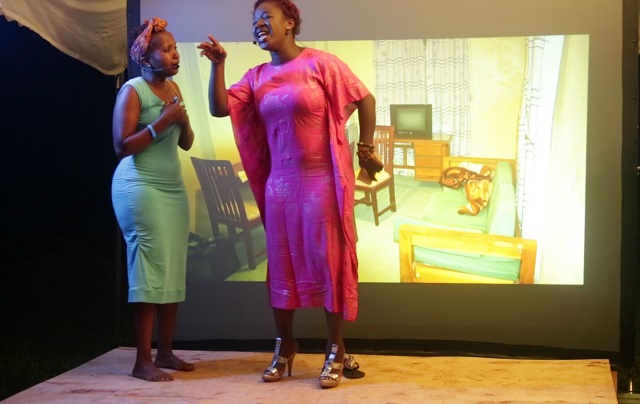
For Love Matters Africa we helped to launch the Love Matters Music Awards: the first music awards in Kenya dedicated to providing young people the chance to produce songs on themes related to pleasure and sexuality.
Working in partnership with the Institute of Development Studies (IDS), as well as East African record label Penya, the project brought together online activities and offline realities, culminating in a live multimedia final: 'Matters of Love: The Show', performed in Nairobi on December 5th.
"During the course of the project, participants from the Penya’s Sauti Academy in Nairobi were coached by international visual artist Iris Honderdos and music producer Arno Peeters (who also made the script for the show), alongside experts on gender and sexuality from IDS and Love Matters."
- Watch all the entries on the Love Matters YouTube channel.
- Read this article from The Guardian or this blog.
BACK TO TOP
Faces of Rosen (Rosen - Bulgaria, 2014)
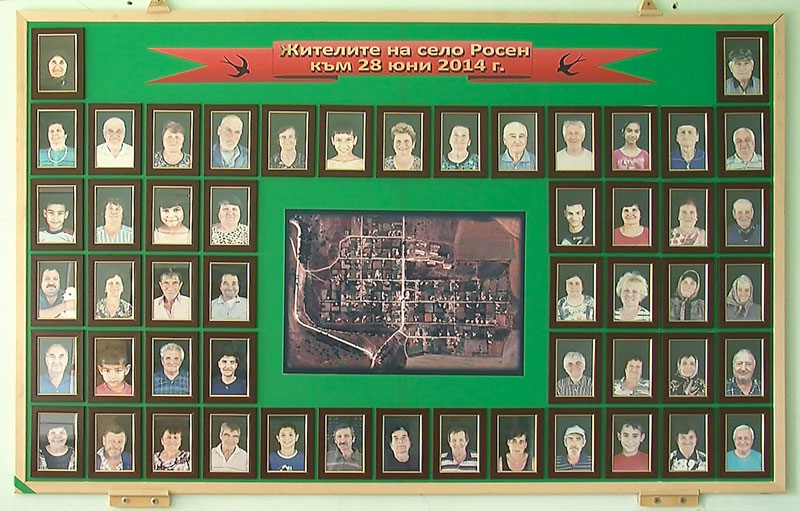
Artproject in cooperation with the inhabitants of Rosen, an almost dreary peasant village in rural Bulgaria, close to the Romanian border.
Like with many villages across rural Europe, urbanization and globalization is having its effect: only old people stay behind and the village withers away. Funeral announcements on displays, trees and houses bare witness to that.
We made a big board with portraits of (nearly) all the people living in Rosen. It serves as a contrast to the decay and is to celebrate that "Rosen is alive".
Read the Travelogue
This video by Iris Honderdos was part of the presentation: Faces of Rosen: (8'19")
Additionally, you can also watch 'Nature of Rosen', a portrait of Rosen's smallest inhabitants
BACK TO TOP
Inside Out (Koudum - The Netherlands, 2013)
Koudum is a small town in Friesland, in north of The Netherlands. It has only 2700 inhabitants. Each year, the local Sculpture Centre organizes an Art Route trough the town, which is a popular local attraction. A great variety of sculptures are on display in the town square, the park and in gardens of the locals.
We were asked to think of a way to involve the inhabitants with the Art Route and with art in general.
Watch an excerpt of a TV item:
(Full item here. 7'48" Frysian only)
BACK TO TOP
Rooted (Mount Elgon - Uganda, 2012)
As the second part of the twin-project “Visualizing Development With Identity”, the Royal Tropical Institute (KIT) asked us to visualize the identity of the Benet people, living on the slopes of Mount Elgon in Uganda.
Over the course of 4 weeks we created a presentation linking their cultural roots to the pressures of their current situation.
Their oral histories were recorded and weaved into a soundscape with sounds from the forests they once used to live in.
During the presentation, 75 Benet were present, some of them had traveled outside their parishes for the very first time in their lives.
Afterwards, the installation traveled to Kampala, accompanied by 15 Benet, to be presented at the Kampala Art Gallery, later that month.
-
Press release (pdf )
-
Article in the Monitor (National Newspaper)
-
Using art to help communities: The Benet Story (Start Journal)
-
Article on Deyu African
Watch a short overview of the creation and launch of the artwork: (7’42”)
and read the installation description
or watch the full documentary (24'44") and listen to the soundtrack.
BACK TO TOP
Red, Gold and Green (Meghalaya - India, 2012)
As the first part of the twin-project “Visualizing Development With Identity”, the Royal Tropical Institute in The Netherlands (KIT) asked Arno and Iris to visualize the identity of the Khasi people, living in the mountainous area of Meghalaya, in the remote North East of India. Over a course of 6-weeks, this resulted in 4 distinctive productions:
- A short video-documentary on Khasi Herbal Healers (View)
- A rap-video with three young local Khasi artists on alcohol-abuse (View)
- A three-dimensional installation with soundscape (Listen)
- A festival to launch the installation with poetry and Khasi musicians working in different musical traditions.
More information (pdf )
Watch an excerpt of the final presentation of the artwork: (7’42”)
And read the raving press reviews the day after...
BACK TO TOP
With Love From.... (Yerevan - Armenia, 2011)
Armenia is somewhat smaller than The Netherlands with 3.2 million inhabitants and a vast diaspora of 8 million living outside the country. In South-West Yerevan, two very different secondary schools are situated opposite each other on a big square: one is a traditional State School, the other more akin to a Waldorf School.
The students of both schools secretly recorded a message from a relative abroad directed to their parents, using Skype. The messages, in sound and text, were used in an installation with 42 umbrellas. The students presented this work in a dance performance, accompanied by a surround soundscape coming from four speakers on the huge buildings surrounding the square.
More information (pdf )
Watch an excerpt of the documentary: (5’27”)
Or watch the full documentary (56’25”)
BACK TO TOP
Turning To Raseborg (Ekenäs - Finland, 2008)
An installation about the opinions from the inhabitants of three villages in Finland about the (than) coming merger into one big municipality called Raseborg.
This merger was a delicate political process since in this area of Finland, the majority is Swedish speaking. Street names had to be changed, and local businesses and municipalities reshuffled.
We interviewed the inhabitants on their views about this forced administrative action and asked them to express them on a triangular piece of fabric. These are brought together in three sails. Each sail contains 48 pieces with writings and drawings on the hope and fear for the possible changes in the future. The sails were suspended in curved metal frames and attached to a centre pole to form a vertical windmill, making the sails ‘chase after each other’ in the wind.
More information (pdf )
Watch an excerpt of the documentary: (7'20')
Or watch the full documentary (30'01")
BACK TO TOP
Cao Bang Festival (Cao Bang - Vietnam, 2007)
This was the third project for the MCNV. Cao Bang is a rural city in the far north that suffers from large-scale drug abuse due to its location near the Chinese border.
Together with the local Sunflowergroup we created a performance in which the audience learns about the difficult lives of these women and the discrimination they suffer, linking the painful stories to the sources of this grief, in particular drug abuse.
It ends with a positive message, showing what society can do to help them.
A big festival was organized around it, as to attract as many youngsters as possible. Especially young males were 'lured' into the evening program to see the Sunflower performance, followed by a breakdance performance by the local 'Satan Crew'. It was a great success.
More information (pdf )
Watch a clip from the Cao Bang Festival: (15’33”)
BACK TO TOP
Cactus Blossoms in The Sand (Hanoi, Vietnam, 2006)
Between 2006 and 2009 Iris and Arno have worked extensively in Vietnam in commission of the Medical Committee Netherlands Vietnam (MCNV) with young women who are infected and affected by illegal drugs and HIV/AIDS. They are organized in the Sunflower and Cactus Blossom groups. The latter one is especially for female ex-drug users and sex-workers.
Trying to find a way to use the life-stories of the members of the Cactus Blossom group in Hanoi and to educate young people about the risks, Arno transformed these into rap, aided by female rapper Kim Jo Jo and translator Le Thuy. Iris shot and edited this video clip.
Unfortunately none of the members are alive today.
More information (pdf )
Watch the clip:
BACK TO TOP
Ukraine Under Construction: Monument for a Revolution (Kiev, Ukraine 2004/2005)
The installation is build around one of the oil drums that was used for heating in the tent camp on the central avenue in Kiev, the Khreshchatyk. It serves as a symbol of the young revolution that was in full swing when we worked there.
Inspired by the beautiful golden roofings on the buildings of Kiev, the oil drum is carried by a cupola of metal arcs with woven metal wires, consisting of words in Ukrainian and in Russian.
They are answers to the question: "What is most important for you in the future?"
We posed this question to many different people in the streets of Kiev and the answers show that in fact, everyone (beyond political differences) is longing for the same things.
Visitors of the artwork were asked to complete the installation by writing words on paper about past matters from they would like to leave behind. After, they were asked to crumble the papers and thrown them inside the cupola below the oil drum. They can be seen as the fuel of the revolution. The light in the middle burns like a fire and shines on the words of hope, casting their shadows on the walls around.
More information (pdf )
Introduction in Dutch (pdf )
Watch Monument for a Revolution: (excerpt 5’32”)
Or watch the full documentary: Monument for a Revolution (19’36”)
BACK TO TOP
Fossile Sound, Memory Mining (Mayrau Mine, Kladno, Czechia, 2004)
Installation and soundscape constructed during the international workshop "Under Construction, a workshop in history, architecture and site-specific art".
Theme of this workshop was the coalmine, which had closed down in 1997, so therefore the workshop
also took place in the industrial complex itself, which now serves as an
open-air museum.
The place was abandoned on the last working day, leaving everything 'as is': from the dirty clothes
and nude pictures on the walls to the soap in the showers.
This installation is based on the memories of miners who have worked in the Mayrau mines.
The miners were asked to write down their thoughts, dreams and fears related to their heavy work underground onto each side of a transparent plastic bag. After that, they'll be asked to blow air into the bags: an exceptional task since most of the miners have trouble breathing as a result of polluted lungs. Their voice and heavy breathing was also recorded.
In one of the two empty elevator shafts, these bags were put into a column formed by a circle of steel wires,
rising from a pile of coals. The bags are floating upwards and around inside the column. The recordings of
their voices and breathings are played through small speakers, hidden inside the pile.
The way the mine appears to visitors now is close to the serene atmosphere found in a cemetery, but in fact
this area was one of the loudest environments one can imagine when it was in operation.
These sounds that once were apparent and familiar to the miners, were invoked in an artistic manner and
diffused through the space of the installation, again using hidden speakers in the ceiling, walls, tubes
and holes in the ground as to bring back the once so lively sounding environment which the workers knew so well.
All part of history now and therefore already auditive fossil's of gone bye days..
More information (pdf )
Watch the full documentary (27'35")
Listen to the composition (17'03")
